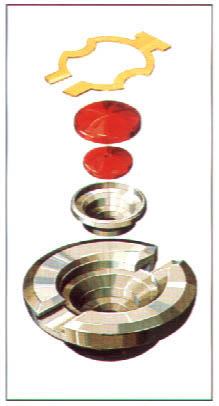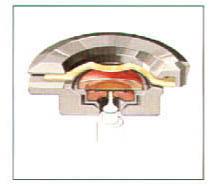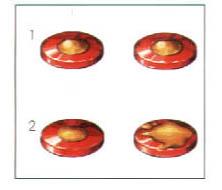|
Once in the past,
whenever a watch had been dropped or suffered a shock, its owner
would bring it to one’s ear with anxiety : was it still alive ?
Very often, one could just realise that the balance-staff pivots
were broken or bent. Then the precious thing was to be brought once
again to the watch-maker for repair. How to protect such frail parts
of a watch movement ? How to reinforce its heart ? These were the
thoughts that kept many watch-makers busy, generation after generation.
Indeed, as early as 1820, balance-staff protected by ‘parachutes’
were mentioned in documents referred to by the ‘Musée International
de l’Horlogerie’ in La Chaux-de-Fonds. It is possible to trace back
the fascinating evolution of the shock-absorber since the patents
have started to be registered, that is in 1888.
An article written by Monsieur F. Glauser on behalf
of Incabloc SA, producer of shock-absorbers, was edited in the ‘Bulletin
SSC n° 25-1997’ of the ‘Société Suisse de Chronométrie’.
It illustrates a few of the outstanding discoveries on the matter.
This article can be sent upon request (see herebelow address).
The “Dictionnaire professionnel illustré de l’horlogerie” gives
the following definition of the shock-absorber as follow : “In a
watch, a resilient bearing designed to damp the shocks that are
brought to bear on the balance-staff pivots. Principle : the endstone
is subject to the action of a spring. If an axial shock occurs,
the endstone can lift slightly until the shoulder strikes a fixed
part of the setting. To damp lateral shocks, the jewel hole is fitted
in the setting comprising an inclined plane, which provides for
a slight lateral shift limited by the collet-arbor or by the roller-arbor,
which strikes a fixed part of the framework.”
Hereafter is one of the products currently used in the watch-making
industry. It is the fruit of long years of improving and perfecting.
1. The spring holds and after a shock puts back in place the mobile
element of the system
2. The end-stone of large diameter, lays inside the setting.
3. The hole-jewel is fitted into the self centering setting.
4. The block includes a double guiding-cone in which the double
cone of the setting is adjusted.
When the intensity of a shock reaches the tolerable limit, the balance
jewels ‘give’ under the thrust of the pivot. This recoiling movement
continues until the resistant portion of the balance staff strikes
against a surface which acts as a stop and absorbs the shock. As
soon as the shock has been neutralised, the pressure of the spring
brings the system back to its initial position. This recentring
is effected immediately with absolute precision. However, the action
of the spring is carefully adjusted : its dimensions and degree
of tension are calculated so that it makes a selection between harmless
shocks and those that may cause damage.
In the conditions in which the watch is normally used, the system
is just as stable as a rigid bearing ( the reaction threshold is
situated at about 35 grams). The diameter of this assembly generally
varies between 1.5 mm and 2.1 mm and the height between 0.35 mm
and 0.90 mm.
It is therefore easy to understand how skilful and meticulous the
watch industry workers must be to produce and assemble such devices.
The assembly is done manually for the smaller calibres, or with
automatic machines for the larger ones. So as to guarantee the good
functioning of the watch, it is necessary to lubricate the points
of contact between the jewels and the balance-staff pivots.
The hole jewels and the end-stones are made of synthetic ruby. They
go through an exclusive method of treatment which causes a real
physico-chemical transformation of the very surfaces of the jewels.
This process intensifies the retention of the oil, improves its
cohesion and favours the formation of an extremely compact drop
(angle of contact 30° instead of 10° or less ). This treatment resists
to at least 8 energetic cleanings with detergents or solvents, and
even with ultrasonic vibrations. The position of the jewels creates
the conditions for perfect retention of oil. Their parallelism and
their symmetry ensure rigorous centring of the oil. The distance
between the end-stone and the hole-jewel remains constant. It is
calculated to provide an optimum result. The oil reserve, contained
in a dust-proof chamber, retains its lubricating properties for
a long period of time.
The excellent quality of the jewels as well as the ‘olived’ shape
of the hole of the hole jewel reduce the friction of the pivots
to its absolute minimum. The balance amplitude therefore retains
its high value in all positions, ensuring good and durable regulation.
The blocks and the settings are profile-turned pieces, generally
made in brass. They are then nickel or gold plated, sometimes also
rhodium plated, according to the customers requests. The springs
are blanked in a special steel and are nearly always gold plated.
The production of each of the pieces which form a shock-absorber,
as well as their assembly, require a high level know how.
There are only few companies in Switzerland who have the capacity
and knowledge to manufacture all or part of this watch component,
a wonder of the world of micro-mechanics.
|




|






